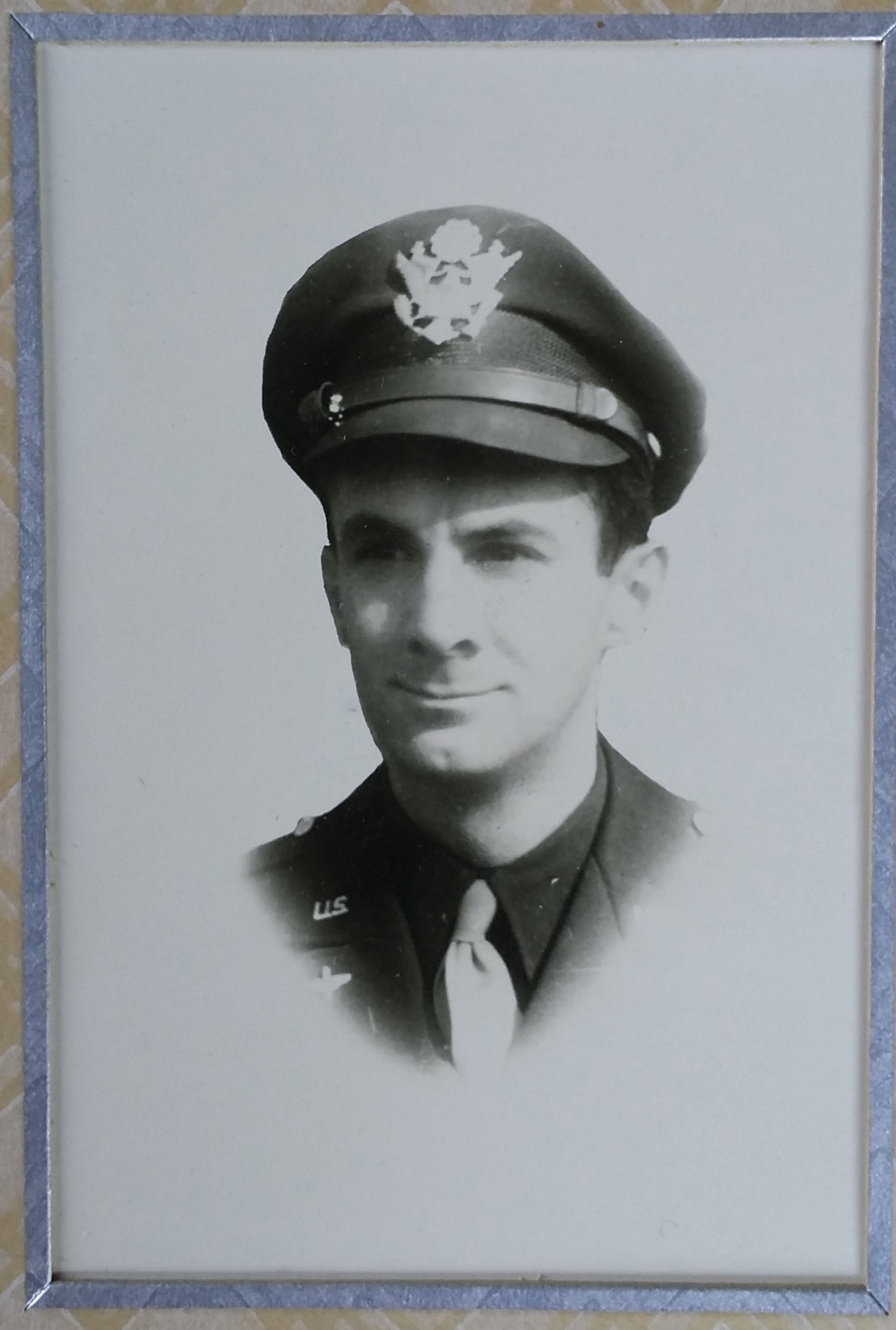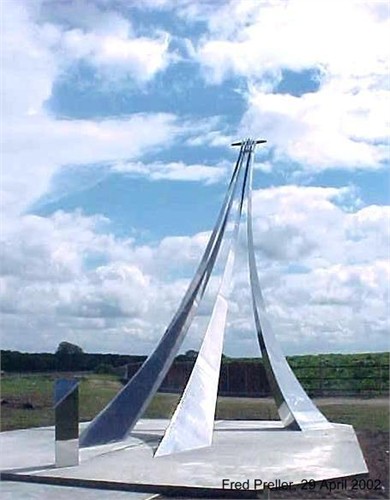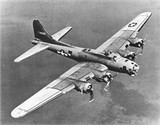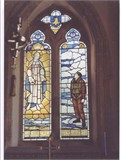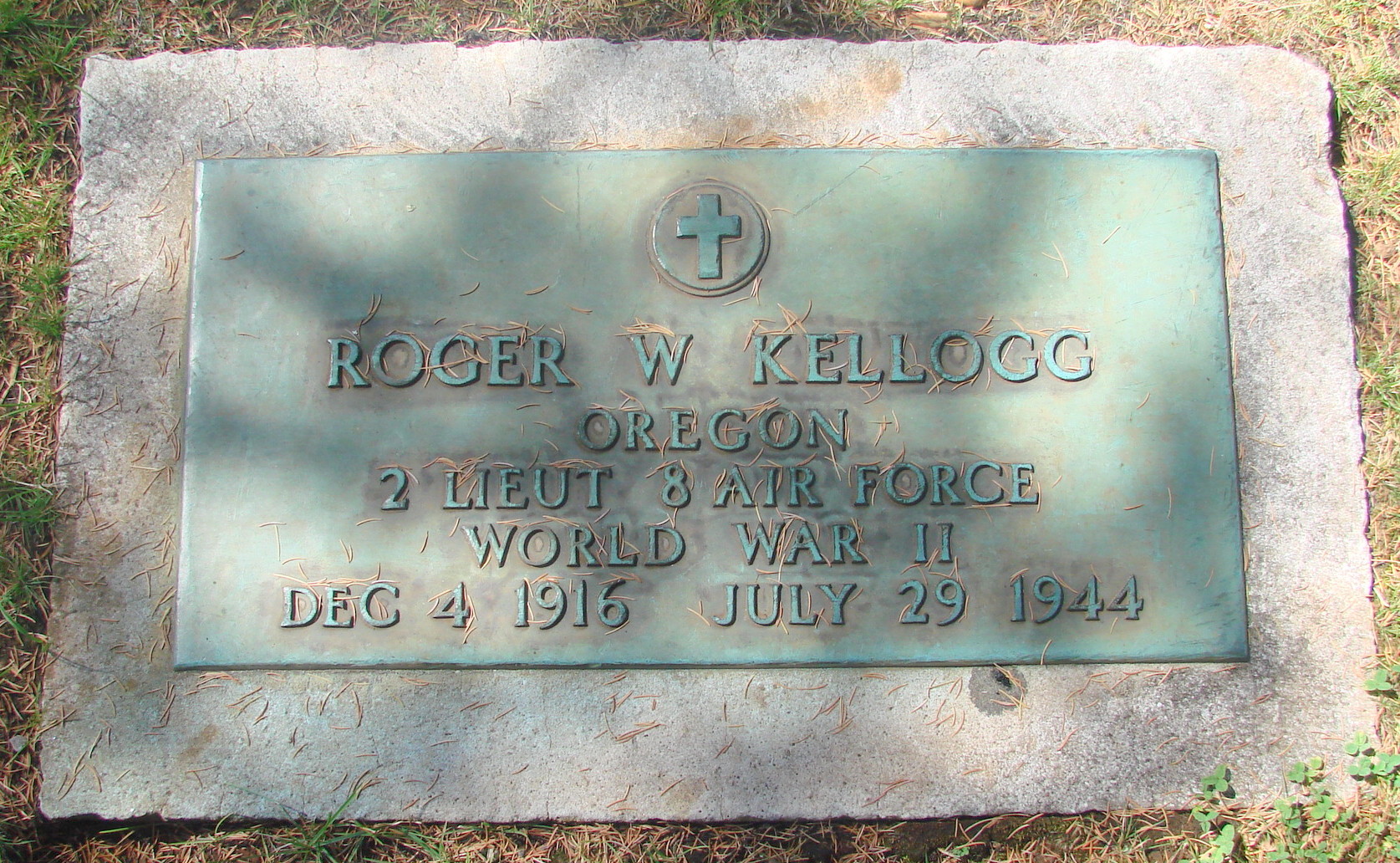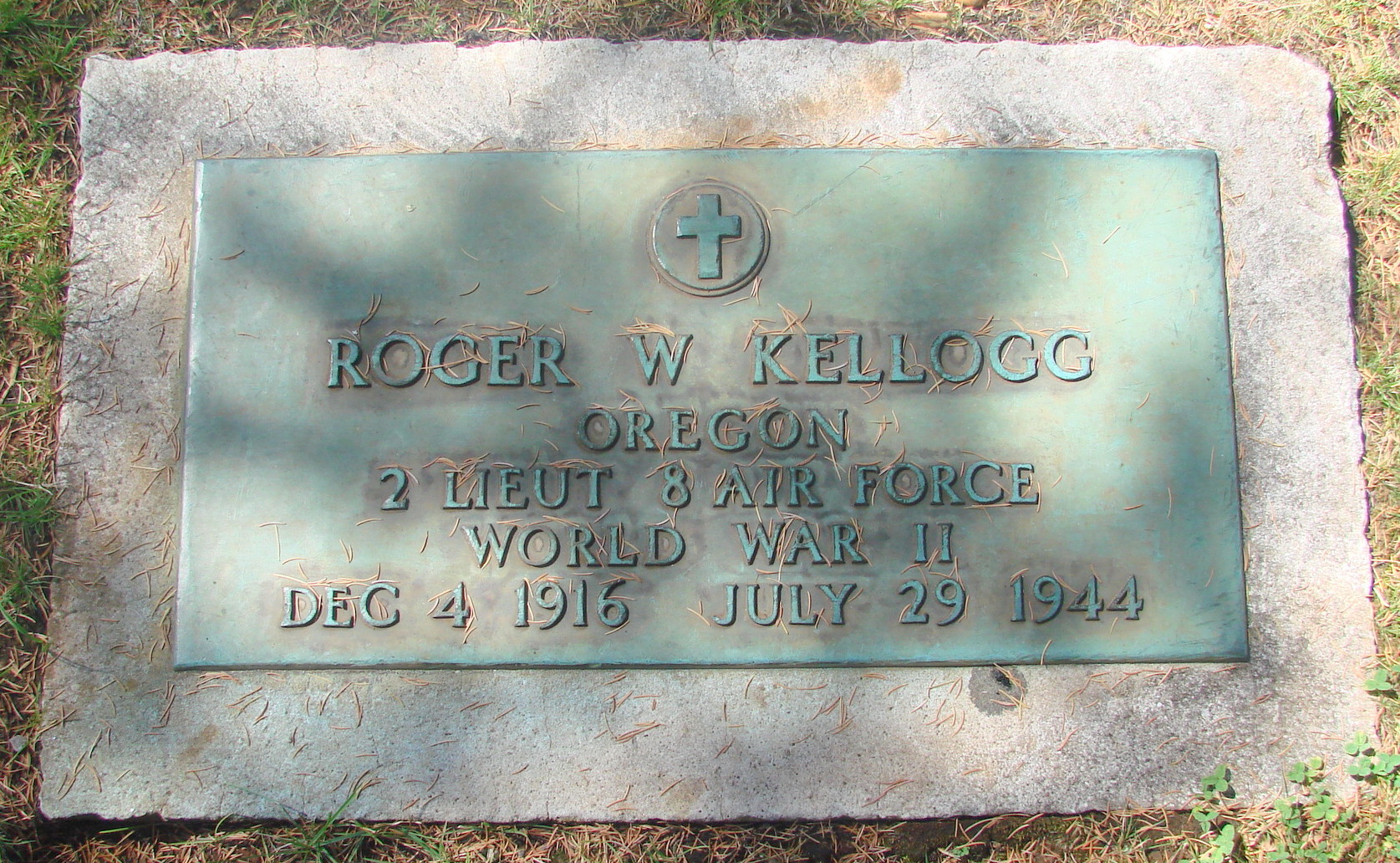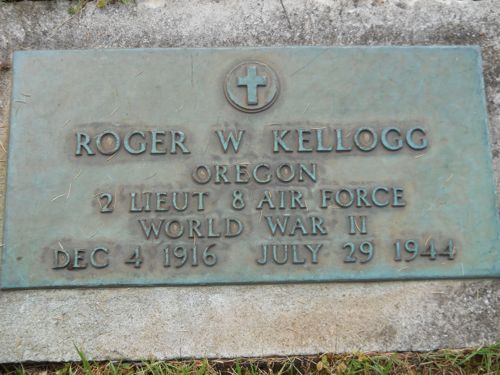Roger Kellogg's Last Flight
Current day video of the B-17 in flight Vimeo
http://vimeo.com/18135369
terrythompson3added this on 15 Feb 2009
Roger William Kellogg B-17 Navigator WWII 338th Squadron, 96th Bomb Group, 8th Air Force USAAF Snetterton Heath Airfield, Station 138. Roger was born in Idaho to Frank R. and Allis (Henry) Kellogg 4 December 1916. He had siblings; Dorothy L., Ruth E. and George H. Kellogg. He was the first husband of Almeda Esther "Peggy" Thompson Cronemiller. Roger married Peggy prior to going to England. Roger Kellogg died 29 July 1944 when his badly damaged B17 crash landed at USAAF , Snetterton Heath Field, Station 138, England. Along with other bomber groups they were staging massive bombing raids on Germany and other targets. His plane was severely damaged by enemy anti-aircraft fire on July 29, 1944. They limped back to base but the pilot, gunner and navigator Roger W. Kellogg were killed on the final crash landing. There were several survivors of the crash including the radio operator Charles Terry. Charles Terry's memory of the event is recorded below. Memoirs of Roger Kellogg's Last Flight By Charles Terry, Onboard Radio Operator http://www.geocities.com/CapeCanaveral/Runway/9601/8th.html Our bombing raid on Leuna Merseberg was our 18th Mission. About four or five minutes before the release line our formation encountered an extremely accurate and intense barrage of flak. We were badly hit in several places. Number three and four engines were severely damaged, the ball turret operator's oxygen system was shot out and so were the inverters. A piece of flak tore out a large section of the nose and struck bombardier Joe Loudermilk in the stomach. Fortunately, a first-class flak suit saved him and he was able to release his bombs on time. Fire broke out in the cockpit and somehow between fighting off E/A top turret gunner Walter Kozlowski managed to put it out with his hands and a fabric cover. Our BTG, Cliff Eastburn kept surviving three to five minutes at a time on portable oxygen bottles which waist gunner, Clair Williams, kept passing it to him. After successfully reaching base with two motors just barely functioning, we had to circle five times. Twice they were cut off on an approach because of poor visibility. On the fifth turn the two damaged engines quit completely. At only 800 feet we were forced to pull up to avoid a collision. The remaining two engines couldn't respond. The plane headed down. Co-pilot Leigh Mann rousted all crewmen into the radio room for a crash landing. For whatever reason Navigator Roger Kellogg and top turret gunner Walter Kozlowski did not come back to the radio room. All except the pilot and co pilot braced themselves against the forward bulkhead in the radio compartment. I could see out the window that the props were just windmilling and oil was gushing all over the cowlings. Then, there were treetops – then a terrible crash and a grinding noise. We crashed into a tree at the end of the runway. Just at the last moment Mann had raised the landing gear and cut the switches. The pilot Lt. Lyle, Navigator and top turret gunner were all killed. The only injury of the crew in the radio room was a gash on the head of T/Sgt. Clair Williams. Our first impression was to get out and run like hell for fear of fire, but we looked toward the front of the plane and saw that there was virtually nothing left but rubble. Lt. Mann had been thrown clear and we moved him to further safety. Both Lyle and Kozlowski were dead. the navigator Lt. Kellogg could not be moved because his back was broken and he was under the left wing tip. I will never forget him looking at us and giving us the OK sign with his forefinger and thumb. He died shortly after. Sgt Kozlowsky died because he delayed going to the radio room in order to warn the navigator and bombardier." Aircraft and Crew: Serial number: 42-97978; Coded BX-B; 338th Squadron. Pilot: Lt. Robert S.Lyle. Killed Co Pilot: Lt. Leigh O. Mann. Injured Navigator: Lt. Roger W. Kellogg. Killed Bombardier: Lt. Joseph H. Loudermilk. Radio Op. T/Sgt. Charles D. Terry. Top Turret: T/sgt Walter Kozlowsky. Killed Ball turret: S/Sgt Clifford G.Eastburn. Waist gunner: S/Sgt. Clair E. Williams. Tail gunner: S/Sgt. Donald E. Sheldon. Unfortunately C.D. Terry died just before Christmas 2008. A monument to their efforts still exists at Snetterton field and down the road at Quidenham, UK there is a chapel with stained glass windows commemorating the fallen airmen.
commemorating the fallen airmen.
Roger Kellogg's Last Flight
Current day video of the B-17 in flight Vimeo
http://vimeo.com/18135369
terrythompson3added this on 15 Feb 2009
Roger William Kellogg B-17 Navigator WWII 338th Squadron, 96th Bomb Group, 8th Air Force USAAF Snetterton Heath Airfield, Station 138. Roger was born in Idaho to Frank R. and Allis (Henry) Kellogg 4 December 1916. He had siblings; Dorothy L., Ruth E. and George H. Kellogg. He was the first husband of Almeda Esther "Peggy" Thompson Cronemiller. Roger married Peggy prior to going to England. Roger Kellogg died 29 July 1944 when his badly damaged B17 crash landed at USAAF , Snetterton Heath Field, Station 138, England. Along with other bomber groups they were staging massive bombing raids on Germany and other targets. His plane was severely damaged by enemy anti-aircraft fire on July 29, 1944. They limped back to base but the pilot, gunner and navigator Roger W. Kellogg were killed on the final crash landing. There were several survivors of the crash including the radio operator Charles Terry. Charles Terry's memory of the event is recorded below. Memoirs of Roger Kellogg's Last Flight By Charles Terry, Onboard Radio Operator http://www.geocities.com/CapeCanaveral/Runway/9601/8th.html Our bombing raid on Leuna Merseberg was our 18th Mission. About four or five minutes before the release line our formation encountered an extremely accurate and intense barrage of flak. We were badly hit in several places. Number three and four engines were severely damaged, the ball turret operator's oxygen system was shot out and so were the inverters. A piece of flak tore out a large section of the nose and struck bombardier Joe Loudermilk in the stomach. Fortunately, a first-class flak suit saved him and he was able to release his bombs on time. Fire broke out in the cockpit and somehow between fighting off E/A top turret gunner Walter Kozlowski managed to put it out with his hands and a fabric cover. Our BTG, Cliff Eastburn kept surviving three to five minutes at a time on portable oxygen bottles which waist gunner, Clair Williams, kept passing it to him. After successfully reaching base with two motors just barely functioning, we had to circle five times. Twice they were cut off on an approach because of poor visibility. On the fifth turn the two damaged engines quit completely. At only 800 feet we were forced to pull up to avoid a collision. The remaining two engines couldn't respond. The plane headed down. Co-pilot Leigh Mann rousted all crewmen into the radio room for a crash landing. For whatever reason Navigator Roger Kellogg and top turret gunner Walter Kozlowski did not come back to the radio room. All except the pilot and co pilot braced themselves against the forward bulkhead in the radio compartment. I could see out the window that the props were just windmilling and oil was gushing all over the cowlings. Then, there were treetops – then a terrible crash and a grinding noise. We crashed into a tree at the end of the runway. Just at the last moment Mann had raised the landing gear and cut the switches. The pilot Lt. Lyle, Navigator and top turret gunner were all killed. The only injury of the crew in the radio room was a gash on the head of T/Sgt. Clair Williams. Our first impression was to get out and run like hell for fear of fire, but we looked toward the front of the plane and saw that there was virtually nothing left but rubble. Lt. Mann had been thrown clear and we moved him to further safety. Both Lyle and Kozlowski were dead. the navigator Lt. Kellogg could not be moved because his back was broken and he was under the left wing tip. I will never forget him looking at us and giving us the OK sign with his forefinger and thumb. He died shortly after. Sgt Kozlowsky died because he delayed going to the radio room in order to warn the navigator and bombardier." Aircraft and Crew: Serial number: 42-97978; Coded BX-B; 338th Squadron. Pilot: Lt. Robert S.Lyle. Killed Co Pilot: Lt. Leigh O. Mann. Injured Navigator: Lt. Roger W. Kellogg. Killed Bombardier: Lt. Joseph H. Loudermilk. Radio Op. T/Sgt. Charles D. Terry. Top Turret: T/sgt Walter Kozlowsky. Killed Ball turret: S/Sgt Clifford G.Eastburn. Waist gunner: S/Sgt. Clair E. Williams. Tail gunner: S/Sgt. Donald E. Sheldon. Unfortunately C.D. Terry died just before Christmas 2008. A monument to their efforts still exists at Snetterton field and down the road at Quidenham, UK there is a chapel with stained glass windows commemorating the fallen airmen.
commemorating the fallen airmen.
Inscription
Oregon
2 Lieut 8 Air Force
World War II




